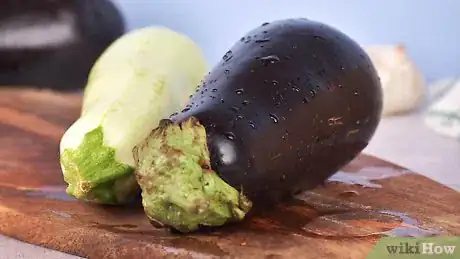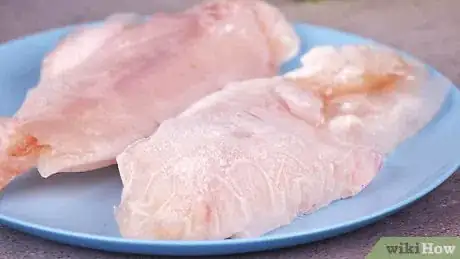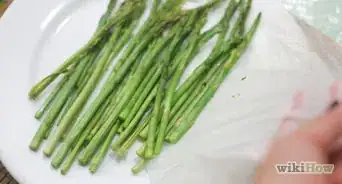This article was co-authored by wikiHow staff writer, Amber Crain. Amber Crain has been a member of wikiHow’s writing staff for the last six years. She graduated from the University of Houston where she majored in Classical Studies and minored in Painting. Before coming to wikiHow, she worked in a variety of industries including marketing, education, and music journalism. She's been a radio DJ for 10+ years and currently DJs a biweekly music program on the award-winning internet radio station DKFM. Her work at wikiHow supports her lifelong passion for learning and her belief that knowledge belongs to anyone who desires to seek it.
There are 16 references cited in this article, which can be found at the bottom of the page.
The wikiHow Culinary Team also followed the article's instructions and verified that they work.
This article has been viewed 54,300 times.
Learn more...
Steaming is a delicious and healthy way to cook many kinds of food. If you don’t have a traditional steamer, no biggie—you can easily steam veggies, fish, and rice in your microwave! All you need is a microwave-safe dish or bowl and something to cover it with and you’re all set. The covering or lid helps to trap the heat and creates the steam that cooks your food. Be careful when you pull the lid away after microwaving your food so the hot steam doesn’t burn you.
Steps
Fresh or Frozen Veggies
-
1Rinse off the veggies thoroughly with water. Place the vegetables in a colander and put the colander in your sink. Then, run fresh water over the veggies to remove dirt and debris. Rub your fingers over their exteriors as you rinse them to get rid of any stubborn dirt.[1]
- Technically, you can steam any veggie in the microwave, but the best options are broccoli, spinach, leafy greens (kale, collards, Swiss chard), cauliflower, asparagus, corn, peppers, carrots, green beans, small potatoes, Brussels sprouts, peas, zucchini, and artichokes. Large, hard potatoes, celery, and squash don’t steam well.[2]
- You may want to soak broccoli and Brussels sprouts in a bowl of cold water for a few minutes to get rid of any bugs.[3]
- You don’t need to rinse or trim frozen veggies! Open the bag and dump them directly into a microwave-safe bowl.
-
2Trim fresh veggies and chop them into bite-sized pieces. Use a sharp knife to trim off any hard ends, fibrous bits, and areas that look yellow, damaged, or bruised. Then, cut the larger veggies into bite-size pieces so they steam evenly and quickly.[4] Follow these guidelines:
- Broccoli and cauliflower: Cut them into 1 inch (2.5 cm) florets or pieces
- Baby carrots and green beans: Trim off the ends but keep them whole.
- Leafy greens: Trim off tough stems and keep the leaves whole.
- Brussels sprouts: Cut in half or leave whole and peel away the outer leaves.
- Artichokes: Peel the fibrous skin off the stalks and leave the stalks whole.
- Regular carrots: Slice into 1⁄4 to 1⁄2 inch (0.64 to 1.27 cm) discs.
- Zucchini: Slice into 1⁄4 to 1⁄2 inch (0.64 to 1.27 cm) discs.[5]
- Small potatoes: Cut into quarters or leave whole and pierce a few times with a fork.[6]
Advertisement -
3Spread the veggies out evenly in a microwave-safe bowl or dish. The veggie pieces can be touching, but try to avoid piling them on top of each other. Since different veggies require different steaming times, it’s best to steam 1 type of veggie at a time.[7]
- Glass, ceramic, and plastic bowls and dishes are safe to use in the microwave.
- Do not put flimsy plastic storage containers (like margarine tubs), take-out containers, plastic grocery bags, or aluminum foil in the microwave.[8]
-
4Add 2 to 3 tablespoons (30 to 44 ml) of water and cover the bowl or dish. The water creates the steam when you heat the veggies. Once you've added the water, cover the container loosely with a plate or heatproof lid so the steam can escape.[9] Microwave-safe plastic wrap, wax paper, parchment paper, and paper towels are also good options for coverings.[10]
- You don’t need to add water if you’re steaming freshly washed leafy greens by themselves.[11]
- Fold up one of the corners if you’re using microwave-safe plastic wrap, parchment, or wax paper to allow steam to escape.[12]
- If you use plastic wrap, make sure it's labeled "microwave-safe" and don't let it touch the food while it’s steaming.[13]
-
5Microwave most veggies on HIGH for 3-5 minutes to steam them. Place the covered dish in your microwave and shut the door. How long you set the cook time depends on the veggies you’re steaming. The thicker and tougher the veggie, the longer it takes. Your microwave’s strength is also a factor.[14] In general, you’ll steam:
- Sliced or baby carrots for 6-8 minutes
- Cauliflower florets and asparagus for 5-6 minutes
- Broccoli florets, spinach, and leafy greens for 5 minutes
- Brussels sprouts for 8-10 minutes
- Green beans for 4-5 minutes
- Peas for 3 minutes
- Small potatoes for 15-20 minutes
- Whole artichoke for 25-35 minutes[15]
-
6Remove the container and place it on a heat-safe surface. Carefully remove the hot container from the microwave, but leave the lid or covering in place. Set the container on a heat-safe surface and wait a few minutes for the steaming process to finish.[16]
-
7Pierce the veggies with a fork to make sure they're tender. Hot steam will escape as soon as you remove the cover, so be careful not to burn yourself. Use a fork to pierce a few of the veggie pieces to check for doneness. If the veggies are tender, they’re ready to eat![17]
- If the veggies are crisp and difficult to pierce, pop them back in your microwave and steam them in 30-second intervals until they’re fork-tender.[18]
Rice
-
1Put 1-2 cups (195-390 g) of rice in a colander and rinse it off. Short-, medium-, and long-grain white rice all work great for this. Use regular rice instead of instant rice. Put the rice of your choice in a colander and rinse it thoroughly with warm water. The warm water hydrates and plumps the rice a bit, which will help it steam more evenly.[19]
- Feel free to use jasmine rice, if you prefer, which has a shorter cook time.[20]
- You can also use brown rice! Just keep in mind that it takes at least 30 minutes longer to steam.[21]
- Long-grain rice is long, slender, and fluffy. Medium-grain rice is shorter, wider, and tends to have a tender, semi-sticky consistency when it’s cooked. Short-grain rice (like sushi rice) has the stickiest texture when it’s cooked.[22]
-
2Transfer the rice to a large microwave safe bowl and add the water. Glass or plastic bowls work fine for this. How much water you add depends on the amount of rice you're steaming. In general, use a 2:1 ratio of water to rice. Stir the rice and water together.[23]
- For example, use 2 cups (236 ml) of water if you're making 1 cup (195 g) of rice.
- Use the biggest container you can find. A 2-1/2 quart (2,365 ml) casserole dish works great.[24]
- As a flavorful alternative, use chicken or beef broth instead of water. The ratio of liquid to rice won't change. If you're making 1 cup (195 g) of rice, use 2 cups (236 ml) of broth.[25]
- Add 1 tablespoon (14.2 g) of butter or margarine for savory results, if desired.
-
3Cover the bowl with a clean dish towel or paper towel. The towel covering absorbs excess steam as the rice cooks, which prevents soggy rice. Drape the towel lightly over the mouth of the bowl. Don’t use a tight-fitting covering or lid! If you do, the rice will boil over and make a mess.[26]
- You can try using a loose-fitting lid for this, but you won't get the same benefits that the towel offers. The towel absorbs excess steam, prevents soggy rice, and keeps the top layer of rice moist. It's the best choice!
-
4Cook covered white rice on HIGH for 10 minutes. Place the covered bowl in the microwave and set it for 10 minutes. Let the full 10 minutes elapse—you don't need to stop and stir the mixture.[27]
- For jasmine rice, cover and cook on LOW (about 30% power) for 20 minutes. Starting at 10 minutes, check the rice mixture every 5 minutes and stir it up. It's done when the water is completely absorbed.[28]
- If you're making brown rice, start by cooking it on HIGH for 5-7 minutes until it starts boiling.[29]
-
5Stir the mixture and keep cooking the rice until it absorbs the liquid. After 10 minutes, remove the cover, stir the rice around, and replace the covering. Continue heating the rice until it absorbs all of the liquid and gets tender. Then, fluff the rice with a fork, let it cool a bit, and dig in![30]
- For white rice, steam it on medium (about 50% power) for 15 minutes.
- For brown rice, microwave on medium-low (about 40% power) for 45-55 minutes until water is absorbed and rice is tender. Let it sit, covered, for 5 minutes before serving it.[31]
Fish Fillets
-
1
-
2
-
3Add your choice of seasonings or toppings to the fillets. You can use almost anything you want for this and you don't need to stress about the amount you use. Just cover the fish with whatever flavors you're in the mood for.[38] Consider seasonings and toppings like:
- Soy sauce, sesame oil, grated ginger, a splash of rice wine, and sesame seeds
- Freshly minced ginger and chopped scallions[39]
- A pat of butter or margarine[40]
- Grated lemon zest, lemon juice, green onions, garlic, salt, and pepper
- Ground cumin, crushed garlic, sweet onion, fresh cilantro, salt, and pepper[41]
-
4
-
5
-
6Remove the fillets and let them sit for 1 minute before eating them. The plastic wrap and meat are very hot, so place the plate on a heat-safe surface and wait about 60 seconds before removing the wrap. Pour any liquid on the plate into the sink. Your steamed fish fillets are ready to enjoy![46]
Things You’ll Need
Fresh and Frozen Veggies
- Knife
- Colander
- Microwave-safe bowl with a lid
- Measuring spoons
Rice
- Colander
- Large bowl
- Spoon
- Cloth or paper towel
- Fork
Fish Fillets
- Sharp knife
- Microwave-safe dish
- Plastic wrap
References
- ↑ https://www.fda.gov/consumers/consumer-updates/7-tips-cleaning-fruits-vegetables
- ↑ https://www.bbcgoodfood.com/howto/guide/how-steam-vegetables
- ↑ https://www.four-h.purdue.edu/foods/Cooking%20fresh%20vegetalbes.htm
- ↑ https://www.bbcgoodfood.com/howto/guide/how-steam-vegetables
- ↑ https://www.seriouseats.com/2017/07/how-to-steam-vegetables-in-the-microwave.html
- ↑ https://www.four-h.purdue.edu/foods/Cooking%20fresh%20vegetalbes.htm
- ↑ https://www.bbcgoodfood.com/howto/guide/how-steam-vegetables
- ↑ https://www.fsis.usda.gov/wps/portal/fsis/topics/food-safety-education/get-answers/food-safety-fact-sheets/appliances-and-thermometers/cooking-safely-in-the-microwave/cooking-safely-in-the-microwave-oven
- ↑ https://www.bbcgoodfood.com/howto/guide/how-steam-vegetables
- ↑ https://www.fsis.usda.gov/wps/portal/fsis/topics/food-safety-education/get-answers/food-safety-fact-sheets/appliances-and-thermometers/cooking-safely-in-the-microwave/cooking-safely-in-the-microwave-oven
- ↑ https://eatfresh.org/recipe/side-dish/microwave-vegetables
- ↑ https://eatfresh.org/recipe/side-dish/microwave-vegetables
- ↑ https://www.fsis.usda.gov/wps/portal/fsis/topics/food-safety-education/get-answers/food-safety-fact-sheets/appliances-and-thermometers/cooking-safely-in-the-microwave/cooking-safely-in-the-microwave-oven
- ↑ https://eatfresh.org/recipe/side-dish/microwave-vegetables
- ↑ https://www.bbcgoodfood.com/howto/guide/how-steam-vegetables
- ↑ https://eatfresh.org/recipe/side-dish/microwave-vegetables
- ↑ https://www.seriouseats.com/2017/07/how-to-steam-vegetables-in-the-microwave.html
- ↑ https://www.four-h.purdue.edu/foods/Cooking%20fresh%20vegetalbes.htm
- ↑ https://www.seriouseats.com/2018/09/how-to-steam-rice-in-a-microwave.html
- ↑ http://smithsonianapa.org/picklesandtea/how-to-cook-rice-3-ways/
- ↑ https://www.chicagotribune.com/news/ct-xpm-1989-06-22-8902110479-story.html
- ↑ https://www.hsph.harvard.edu/nutritionsource/food-features/rice/
- ↑ https://www.hsph.harvard.edu/nutritionsource/food-features/rice/
- ↑ http://smithsonianapa.org/picklesandtea/how-to-cook-rice-3-ways/
- ↑ https://www.chicagotribune.com/news/ct-xpm-1989-06-22-8902110479-story.html
- ↑ https://www.seriouseats.com/2018/09/how-to-steam-rice-in-a-microwave.html
- ↑ https://www.seriouseats.com/2018/09/how-to-steam-rice-in-a-microwave.html
- ↑ http://smithsonianapa.org/picklesandtea/how-to-cook-rice-3-ways/
- ↑ https://www.chicagotribune.com/news/ct-xpm-1989-06-22-8902110479-story.html
- ↑ https://www.seriouseats.com/2018/09/how-to-steam-rice-in-a-microwave.html
- ↑ https://www.chicagotribune.com/news/ct-xpm-1989-06-22-8902110479-story.html
- ↑ https://www.epicurious.com/recipes/food/views/steamed-fish-fillets-with-scallion-ginger-oil-12170
- ↑ https://www.bbcgoodfood.com/recipes/steamed-salmon-microwave
- ↑ https://www.delish.com/cooking/a37187/how-to-cook-fish-micro-steaming/
- ↑ https://www.bonappetit.com/story/how-to-safely-thaw-frozen-fish
- ↑ https://www.fsis.usda.gov/wps/portal/fsis/topics/food-safety-education/get-answers/food-safety-fact-sheets/appliances-and-thermometers/cooking-safely-in-the-microwave/cooking-safely-in-the-microwave-oven
- ↑ https://www.epicurious.com/recipes/food/views/steamed-fish-fillets-with-scallion-ginger-oil-12170
- ↑ https://www.delish.com/cooking/a37187/how-to-cook-fish-micro-steaming/
- ↑ https://www.bbcgoodfood.com/recipes/steamed-salmon-microwave
- ↑ https://www.food.com/recipe/microwave-salmon-fillets-37713
- ↑ https://www.delish.com/cooking/a37187/how-to-cook-fish-micro-steaming/
- ↑ https://www.epicurious.com/recipes/food/views/steamed-fish-fillets-with-scallion-ginger-oil-12170
- ↑ https://www.fsis.usda.gov/wps/portal/fsis/topics/food-safety-education/get-answers/food-safety-fact-sheets/appliances-and-thermometers/cooking-safely-in-the-microwave/cooking-safely-in-the-microwave-oven
- ↑ https://www.epicurious.com/recipes/food/views/steamed-fish-fillets-with-scallion-ginger-oil-12170
- ↑ https://www.epicurious.com/recipes-menus/how-to-cook-fish-in-the-microwave-papillote-article
- ↑ https://www.bbcgoodfood.com/recipes/steamed-salmon-microwave























































